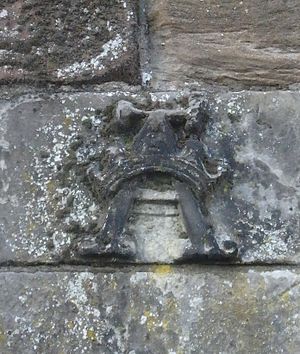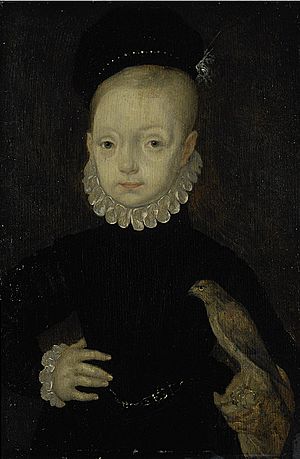Annabell Murray, Countess of Mar facts for kids
Annabell Murray (1536–1603) was an important Scottish noblewoman. She was a landowner and worked at the royal court. She is most famous for looking after King James VI and his son, Prince Henry, at Stirling Castle.
Annabell was the daughter of Sir William Murray of Tullibardine. Her mother was Katherine Campbell. Her nephew was John Murray, 1st Earl of Tullibardine. In old documents, her name was often written as "Annabell" or "Annable".
Contents
A Lady at Court
Annabell Murray was a lady-in-waiting to Mary of Guise, the Queen Regent of Scotland. In 1557, she married John Erskine, Lord Erskine.
Some people, like the religious leader John Knox, did not like Annabell. He thought she was too close to Mary of Guise and later to Mary, Queen of Scots.
In 1566, Mary, Queen of Scots, was pregnant with her son, James. She showed how much she valued Annabell by giving her many precious jewels in her will. These included belts with chrysolite and pearls, bracelets with diamonds, and pearl earrings. She also received a special fur piece called a zibellino and a belt with a tiny portrait of Henri II of France. These gifts showed that Annabell was a very close and trusted friend of the Queen.
In 1565, Mary, Queen of Scots, made Annabell's husband, John Erskine, the Earl of Mar. They asked a goldsmith in Edinburgh, James Cockie, to make silver decorations for a rock crystal jug. This jug, known as the "Erskine ewer," has their family symbols on it.
Raising a King and a Prince at Stirling Castle
Mary, Queen of Scots, gave birth to Prince James in June 1566. A month later, she visited Annabell and her husband at Alloa Tower. In August 1566, Lord Darnley, the Queen's husband, was jealous of how close Annabell was to the Queen. Annabell was given silver thread to embroider clothes for the young prince.
In March 1567, Mary, Queen of Scots, trusted Annabell Murray with her baby son, James. He was to be raised safely at Stirling Castle. After the Earl of Bothwell married the Queen, he tried to take the prince from Stirling. But the Earl of Mar cleverly found ways to stop him.
Mary, Queen of Scots, was later captured and gave up her crown. Her half-brother, James Stewart, became the ruler of Scotland. He gave Annabell £500 to pay the "rockers," who were women who rocked the king's cradle.
Lady Mar was in charge of a large household that looked after the young king at Stirling Castle. This household included a Master of Household, a "provisor" who bought food, and a chief nurse named Helen Littil. Five ladies took turns rocking the king's cradle. Musicians played their viols, and there were cooks and brewers. Margaret Balcomie washed the king's clothes.
In January 1570, Mary, Queen of Scots, who was held captive in England, sent clothes to James VI at Stirling. She wanted these to be the first proper clothes from his mother. She wrote to Annabell that the gift was missing buttons. Annabell managed to get Mary's buttons for James three years later.
Annabell often wrote letters about the king's health. She would say, "the Kingis Majestie is rycht blyth (praise to God)," meaning the King was very happy. This was comforting during the difficult years of the Marian Civil War. In one of his first letters, James called Annabell "Lady Minny." Elizabeth I of England also sent a letter in 1572, thanking Annabell for taking good care of the king. Annabell's own son, John, and her nephew, Sir William Murray, were childhood friends of James VI.

John Erskine, Annabell's husband, became the Regent of Scotland in 1572. He died in October 1572. Annabell Murray continued to look after the king at Stirling. She was helped by Mar's younger brother, Alexander Erskine of Gogar, who was the Master of Mar. His three sons also joined the king in his schoolroom.
Buttons and a Football for the King
In May 1573, the "Lang Siege" of Edinburgh Castle ended. A chest containing Mary, Queen of Scots' jewels was found. In July 1573, Regent Morton sent some of these jewels to Annabell Murray. These included gold buttons to be sewn onto the king's clothes. Morton also had 60 new gold and silver buttons made for James VI. He even bought the king a football! The king's room at Stirling was decorated with oak panels. Morton also paid the wages of James's nurse, Helen Litill, and other staff. Annabell Murray received many jewels over the years until 1579, when the King was declared an adult and moved to Edinburgh. One special jewel was a fossil shark tooth set in gold. This was an amulet meant to protect the king from any poisons in his food.
Royal School Days

In 1573, Regent Morton wanted the king to be less looked after by women. However, a year later, the king's teachers, George Buchanan and Peter Young, said he was still "guyded and kept" by women, except when he was studying. By May 1574, James started wearing adult clothes, like a suit of red taffeta.
When the English ambassador, Henry Killigrew, visited Stirling Castle in 1574, he met Annabell Murray. He saw the eight-year-old king speaking French and Latin. James could translate from the Bible without practice. His teachers also made the king dance for the ambassador. There's a story that Annabell Murray once tried to stop James's tutor, George Buchanan, from physically punishing the king. James also had a French classmate, Jérôme Groslot de l'Isle.
In 1575, Andrew Melville and his nephew James Melville visited the king. They heard him talking about "knowledge and ignorance" while walking with "auld Lady Marrs hand," which means Annabell Murray. This shows she helped him practice his speaking skills.
Kindness and Ambition
Sir James Melville wrote about the people around the king. He described Annabell Murray as "wise and sharp." He also noted that Peter Young was kinder to the king than George Buchanan.
Pet Birds and Shoes
Records from the royal household show a long bill for shoes for James. Annabell signed this bill with William Murray, who worked in the king's room. Other staff included the king's tailor, shoemaker, and glove maker. William Murray bought cords to hang cages for James's pet birds at Stirling Castle. He also bought hemp seeds for them and decorated James's study with green fabric.
In 1577, Annabell wrote to her brother-in-law, telling him not to come to Stirling because Regent Morton was visiting. Her brother-in-law wanted to bring a woman accused of witchcraft, and Annabell advised him to get written statements from her accusers first.
In 1579, the Earl of Atholl died after a banquet at Stirling Castle. His wife was also unwell. Rumors spread that they had been poisoned. Annabell Murray's sister-in-law wrote to her, saying the accusations against Annabell were "forged lies."
Around this time, the king had his portrait painted for the second time by a Flemish artist, likely Arnold Bronckhorst.
Annabell Murray played a big part in the transfer of power from Regent Morton to the king in 1578. In 1581, she asked for a reward that had been promised for her services to the young king. She was also important during changes in government in 1584.
Anne of Denmark and Prince Henry
In May 1590, Annabell was one of the main ladies who welcomed Anne of Denmark when she arrived in Scotland. At Anne of Denmark's coronation on May 17, 1590, Annabell held the queen's long dress and helped open her gown for the anointing ceremony.

In 1594, Annabell Murray became the guardian of King James's son, Prince Henry, at Stirling Castle.
Prince Henry was born at Stirling. Many doctors and nurses helped with his birth. Other members of Annabell's family joined this new royal household. These included her sisters as dames of honour, a keeper of linen, and a master of the wardrobe. The Prince's nurse was Margaret Masterton. At Henry's baptism in August 1594, Annabell's role was to lift the prince from his bed and pass him to the Duke of Lennox, who then gave him to the English ambassador. She also held him in the chapel until the service began.
In December 1594, there was a problem with the prince's wet nurse because she became ill. A new nurse was appointed. Some people criticized Annabell Murray because she had chosen the first nurse.
Other important people in Prince Henry's household were the seamstress and the laundress, who was given soap and laundry starch.
Anna of Denmark did not like that her son was not with her. Her attempts to get her son back caused problems for Annabell and her son, John Erskine, Earl of Mar (1558–1634). When Anne of Denmark planned to visit her son in April 1595, "Old Lady Mar" was asked to leave Stirling Castle.
Later Life
In July 1599, the King gave a special gift to Annabell and her son for their loyal service. The King noted her old age and how her body was "waist and extenuat" (worn out) from her past work. If she died, the gift would go to her daughter, Marie Erskine. Marie Erskine also helped look after Prince Henry at Stirling.
In 1600, King James VI gave Annabell a property in Stirling called the "heuch and brae of Parkhill." He also formally thanked her for her service in keeping Prince Henry.
Annabell Murray died in February 1603. According to a minister named Archibald Simpson, she "peacefully ended her days, respected by all, hated by none." On May 7, 1603, her daughter-in-law, Marie Stewart, Countess of Mar, stopped Anne of Denmark from taking Prince Henry from the castle.
Annabell's other homes included Mar's Wark and Alloa Tower, and a house in Edinburgh. The National Museum of Scotland has a chair carved with her initials and three stars from her family's crest. There is also a cradle said to have been for the infant king or prince.
Annabell made more than one will. In her will from 1601, she listed her farm animals and lands. She wanted to be buried at the new burial place at the church of Alloa, next to her husband. She also wanted the bodies of her husband's ancestors to be moved from Cambuskenneth Abbey to Alloa, as her husband had wished.
Jewels and Medicine
In her will from 1602, she left her jewelry to her family. This included a gold locket showing the story of Abraham and Isaac. Another locket had a picture of a hard stone called an "adamant" being hit by two hammers. She explained this to her son: "just as the pressing hammers cannot break the adamant, no man should let his duty to God, his prince, and his parents be broken or overcome." She also had expensive clothes, like a cloak called a "mandell" decorated with rubies, diamonds, and "pictures." New gold bracelets or rings with her initials were made for some male family members. She also made medicine with a servant and left her both medicine and equipment for distilling.
|
See Also

